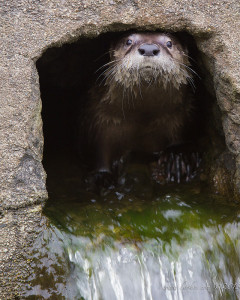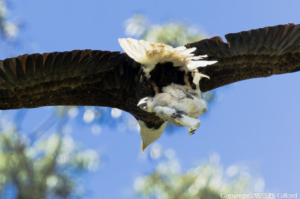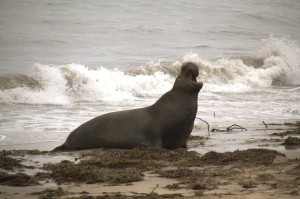A new North American river otter exhibit at the Aquarium of the Bay proves that sometimes a good cause just needs the right representative. To make visitors aware of the benefits of a clean watershed, the Aquarium has prepared a 1,000 square-foot habitat for three rascally river otters named Shasta, Tubbs, and Wildcat.
The exhibit first opened to the public last Friday after almost two months of preparation, and the otters were an immediate hit with visitors, who eagerly followed their every move. Outfitted with flowing pools, trees, and shady alcoves, the exhibit was painstakingly crafted to be, in the words of public relations coordinator Mallory Johnson, a “local watershed destination.”
“What makes them such great ambassadors (for the watershed) is how fun and playful they are,” said Johnson. “We’re really excited to have them here.”

In some places, such as in Marin County, river otters are making a resurgence. With hikers and sightseers providing the brunt work, the River Otter Ecology Project has tracked otter movements across the Bay Area. Many inhabit Marin’s western coast, and one has even taken up residence at Sutro Baths in San Francisco. Famously known as Sutro Sam, this ambitious river otter is thought to have braved the San Francisco Bay by crossing at the Golden Gate, and has created a buzz among locals and tourists alike. Thanks to Aquarium, seeing river otters just got a little bit easier.
Yet despite these encouraging signs, otter populations in California and the Bay Area are already much depleted. While not endangered, habitat loss and pollution are still major threats to our peaceful coexistence. To bring awareness to the issue, the Aquarium of the Bay named each of their three new inductees for local watershed landmarks: Shasta for Mt. Shasta in Siskiyou, Tubbs for Tubbs Island in Sonoma, and Wildcat for Wildcat Creek in San Pablo.
But environmental degradation isn’t the only threat to river otters, and it isn’t the reason Shasta, Tubbs and Wildcat were saved. Hailing from Louisiana, these otters were discovered and saved by professional trappers from the fur trade.

“We couldn’t believe that there even was a fur trade anymore,” Johnson exclaimed, explaining that because the otters feast on cultured crayfish, an industry worth almost $200 million in Louisiana, they’re considered pests. In order to curb their numbers, the fur trade has remained legal in Louisiana.
After the decline of sea otter and lion populations along the West Coast in the early 1800s, trappers in the fur trade began to target inland species, including beavers, foxes, and river otters. The otters were especially prized for their velvety pelts — they have 156,000 hairs per square inch. That’s more than an entire human head, and this caused their pelts to become the luxury good that, in some places, it still is today.
Luckily for the Aquarium’s three new adorable ambassadors, they have received immunity from that fate. Aside from the occasional temporary changes, the otters will be permanent fixtures of the Aquarium.
Want to learn more before relaxing with the otters and learning from the docents? Read up on your otter facts here, or check out these videos produced by the Aquarium!
Jackson Mauze is a Bay Nature editorial intern.





